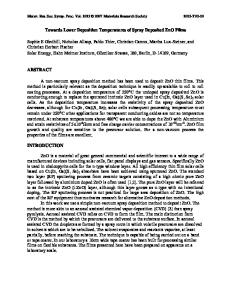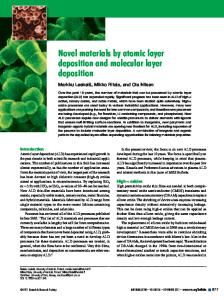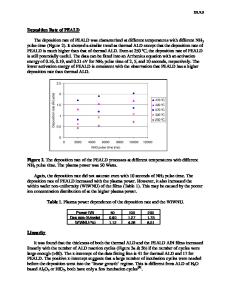AlN Films Deposited by LP-MOCVD Atomic Layer Deposition at Lower Temperatures Using DMEAA and Ammonia
- PDF / 442,972 Bytes
- 6 Pages / 414.72 x 648 pts Page_size
- 72 Downloads / 308 Views
Mat. Res. Soc. Symp. Proc. Vol. 395 ©1996 Materials Research Society
Torr (DMEAA) at 20 0C), making it suitable for CVD processes.[16, 17] We recently reported the deposition of AIN thin films using DMEAA and ammonia in an atmospheric MOCVD process.[22] In a typical ALD process, source gases are alternately introduced to the substrate surface by methods such as switching gas flows in a sequential manner or using a rotating the substrate under the flow of separate gas streams.[5, 24] Under proper conditions adsorption of the reactant species to the surface is self-limiting to a single monolayer per reactant step. Through these selflimiting surface reactions a film can be deposited one atomic layer at a time. Although the growth rates can be inherently low, the nature of the process makes it particularly effective for creating abrupt interfaces and heterostructures and for depositing material of high crystalline quality at lower temperatures.[25, 26] One cycle of a typical ALE process for depositing a binary compound consists of 4 steps: 1.) a pulse of reactant 1 for A seconds, 2.) a flush of pure carrier gas for B seconds, 3.) a pulse of reactant 2 for C seconds, 4.) a flush of pure carrier gas for D seconds. A process is commonly labeled by the pulse duration and this sequence would then be an A-B-C-D process. In the experiments reported here, DMEAA is employed with ammonia as the nitrogen source. The ALD technique was chosen in order to minimize gas phase reactions between the DMEAA and ammonia and to promote site selective surface reactions which can lead to more ordered growth at lower temperatures. EXPERIMENTAL The deposition is carried out in a horizontal laminar flow all-quartz near-atmospheric MOCVD reactor equipped with three-way flush valves. The reactor was operated at 25 - 100 Torr using purified H2 as a carrier gas. The substrates were placed on a SiC coated susceptor and heated with rf induction. Deposition was done on Si(100), A12 0 3 (0001), A12 0 3 (0112) substrates. The substrates were prepared for deposition by a standard degreasing procedure using TCA, acetone, methanol and deionized H 2 0. The Si wafers were oxide etched in 10% (by volume) aqueous HF solution and air dried immediately before loading into the reactor. The substrates were heated to 1083 K (810 'C) under a H2 flow for 10 minutes prior to starting the ALD process. The DMEAA was contained in a stainless steel bubbler and held at 293 K during processing. The bubbler was stored at 280 K to suppress decomposition of the precursor. In our experiments we have explored deposition at a range of conditions. The total flow through the reactor was 2.4 - 6.0 slm and was held constant during each of the process steps. We used gas velocities of 6 - 50 cm/s, DMEAA partial pressures of 2.9 - 24.6 mTorr and ammonia partial pressures of 1.8 - 15.4 Torr with a constant V/Ill of 620. The H2 flow through the bubbler was 0.3 slm and the NH 3 flow into the reactor was 0.3 slm. Details of the reactor system and process were previously described.[22] RESU
Data Loading...










